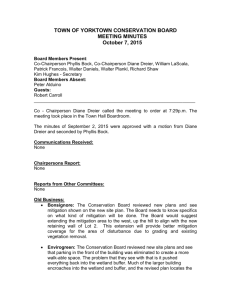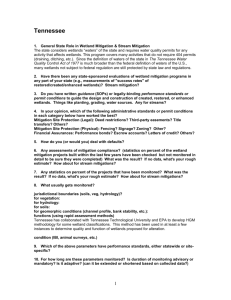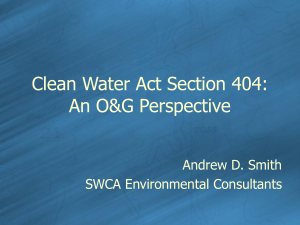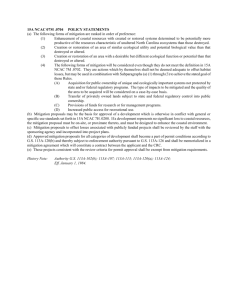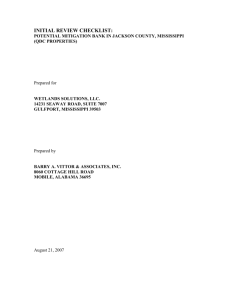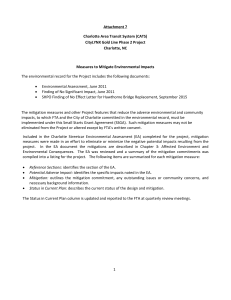Texas - Association of State Wetland Managers
advertisement
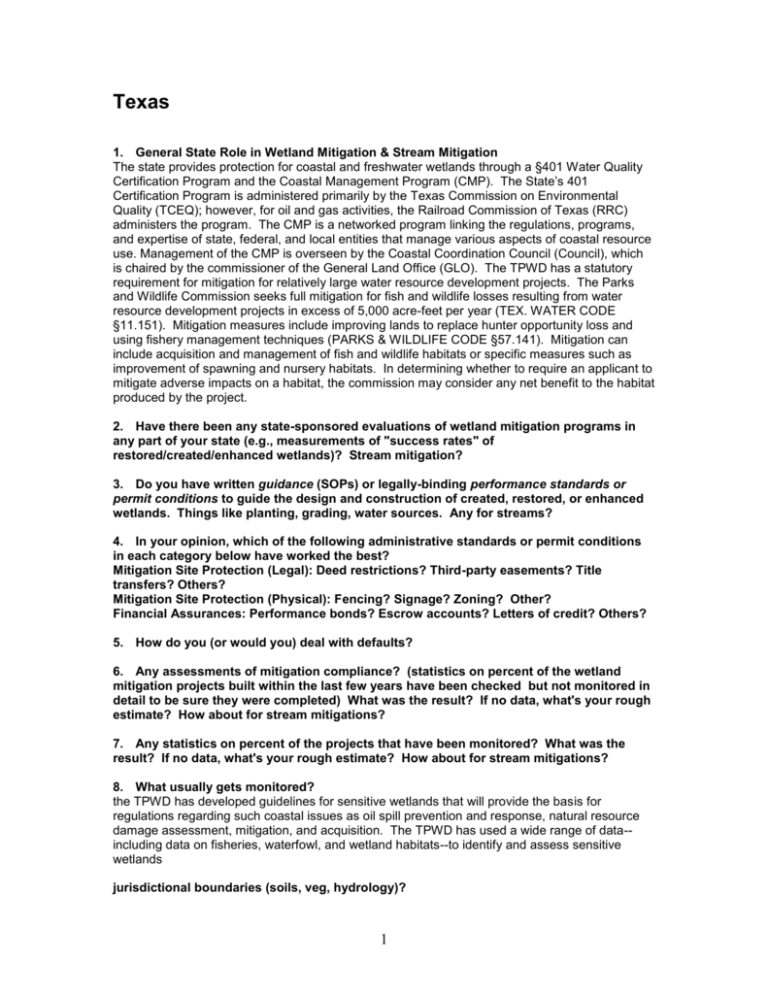
Texas 1. General State Role in Wetland Mitigation & Stream Mitigation The state provides protection for coastal and freshwater wetlands through a §401 Water Quality Certification Program and the Coastal Management Program (CMP). The State’s 401 Certification Program is administered primarily by the Texas Commission on Environmental Quality (TCEQ); however, for oil and gas activities, the Railroad Commission of Texas (RRC) administers the program. The CMP is a networked program linking the regulations, programs, and expertise of state, federal, and local entities that manage various aspects of coastal resource use. Management of the CMP is overseen by the Coastal Coordination Council (Council), which is chaired by the commissioner of the General Land Office (GLO). The TPWD has a statutory requirement for mitigation for relatively large water resource development projects. The Parks and Wildlife Commission seeks full mitigation for fish and wildlife losses resulting from water resource development projects in excess of 5,000 acre-feet per year (TEX. WATER CODE §11.151). Mitigation measures include improving lands to replace hunter opportunity loss and using fishery management techniques (PARKS & WILDLIFE CODE §57.141). Mitigation can include acquisition and management of fish and wildlife habitats or specific measures such as improvement of spawning and nursery habitats. In determining whether to require an applicant to mitigate adverse impacts on a habitat, the commission may consider any net benefit to the habitat produced by the project. 2. Have there been any state-sponsored evaluations of wetland mitigation programs in any part of your state (e.g., measurements of "success rates" of restored/created/enhanced wetlands)? Stream mitigation? 3. Do you have written guidance (SOPs) or legally-binding performance standards or permit conditions to guide the design and construction of created, restored, or enhanced wetlands. Things like planting, grading, water sources. Any for streams? 4. In your opinion, which of the following administrative standards or permit conditions in each category below have worked the best? Mitigation Site Protection (Legal): Deed restrictions? Third-party easements? Title transfers? Others? Mitigation Site Protection (Physical): Fencing? Signage? Zoning? Other? Financial Assurances: Performance bonds? Escrow accounts? Letters of credit? Others? 5. How do you (or would you) deal with defaults? 6. Any assessments of mitigation compliance? (statistics on percent of the wetland mitigation projects built within the last few years have been checked but not monitored in detail to be sure they were completed) What was the result? If no data, what's your rough estimate? How about for stream mitigations? 7. Any statistics on percent of the projects that have been monitored? What was the result? If no data, what's your rough estimate? How about for stream mitigations? 8. What usually gets monitored? the TPWD has developed guidelines for sensitive wetlands that will provide the basis for regulations regarding such coastal issues as oil spill prevention and response, natural resource damage assessment, mitigation, and acquisition. The TPWD has used a wide range of data-including data on fisheries, waterfowl, and wetland habitats--to identify and assess sensitive wetlands jurisdictional boundaries (soils, veg, hydrology)? 1 for vegetation: for hydrology: for soils: for geomorphic conditions (channel profile, bank stability, etc.): functions (using rapid assessment methods) A modified WET (Wetland Evaluation Technique) has been used to evaluate wetlands for the mitigation banking programs. condition (IBI, animal surveys, etc.) 9. Which of the above parameters have performance standards, either statewide or sitespecific? 10. For how long are these parameters monitored? Is duration of monitoring advisory or mandatory? Is it adaptive? (can it be extended or shortened based on collected data?) 11. Have there been any legal opinions regarding any of the performance standards or permit conditions? What were the outcomes (which ones are enforceable?) 12. For approximately what percent of the projects was the above data collected BEFORE a site was restored or enhanced? (i.e., baseline data). 13. If no standardized monitoring guidance, who decides what to monitor? e.g., MBRT? 14. Are the construction and monitoring specifications or guidance the same for mitigation bank wetlands as for other mitigation wetlands? 15. Does the party that designed the mitigation project always do the monitoring? If not, who? 16. Does any state agency keep a wetlands permit ledger, tracking system, or database? What does it track? (data fields) Streams too, or separate? The GLO uses an Access Database to track projects being reviewed for consistency in the coastal zone. There is no database that specifically addresses restorations, enhancements, and creations. 17. Is the tracking system easily accessible to the public? If not, what arrangements exist for interagency sharing of raw data or the database? 18. Can the data be displayed automatically on maps? 19. Does the state do any wetland mapping of its own? 20. Have there been any attempts to use wetland delineations (done for 404 permits) to update small areas of existing wetland maps? 21. Have HGM class codes been added to NWI or other wetland maps? 22. Have maps been overlaid with other GIS layers to generate statistical profiles of wetlands in any region or watershed? 23. Contact for state agency wetland mapping/ GIS efforts or permit tracking database? 24. Contact for state transportation department, wetlands mitigation person? 2 25. Contact for stream impact mitigation program, if separate? 26. Can you send us (1) mitigation performance guidelines or standards? 27. Can you send us (2) case history of a good mitigation project, in terms of administrative and technical performance standards, monitoring, adaptive management, etc.? 28. Can you send us (3) list of data fields in the wetland tracking system (if any)? 29. Other contacts suggested? 3



